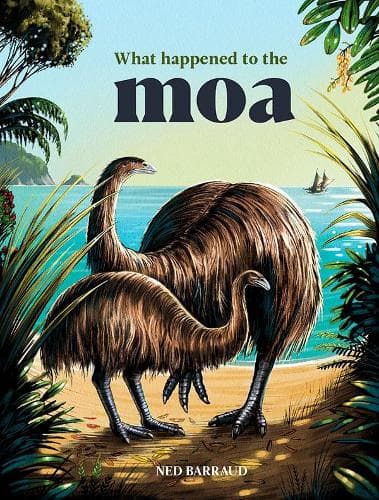What Happened to the Moa
Reviewed by Dionne Christian
The essay, for an Honours history paper, was called American Encounters and asked for – in 5000 words – a consideration of how set readings about European/Indigenous American encounters illuminate gnarly issues in cultural history.
At the beginning, struggling to get to grips with the lifeways of various Native American groups, I just wanted a kids’ books where everything is explained in simple language and pictures so you can start to form images in your own mind and move on to the (way) more advanced stuff from there.
Reading Ned Barraud’s book What Happened to the Moa reminded me of this. It’s the kind of illustrated non-fiction ostensibly for children but done well enough for older readers to find engaging. Indeed, both groups could find it a jumping off point for further investigation into how one of the biggest creatures ever to walk Aotearoa died out.
I think it’s fair to say many of us have a morbid curiosity around this. How could something as big and supposedly formidable as a giant moa exist one moment and not the next? What role did humans play in this? Did anything, other than humans, prey on them?
Barraud sticks to the science, marshalling the latest research to discover what happened to Aotearoa’s famed flightless bird. It’s worth noting that while readers may have questions, there isn’t a question mark in the title of his picture book.
It confidently presents the facts in an easy-to-read manner and the information, while instructive, is always interesting. Barraud’s convincing illustrations do a great job of supporting a story which starts millions of years ago with the arrival of moa and goes right through to 2019, when moa prints were discovered in a Central Otago riverbed.
This discovery prompted Wellington-based Barraud to research and write about moa. He admits it was a challenge, so he enlisted experts Professor Trevor Worthy and Dr Mike Dickison to bring him up to speed with what we now know about the life and death of the moa.
Barraud has distilled their knowledge into a clear and lively story – and it also altered the way he drew moa. It used to be thought that they were more upright, but it’s now known they carried their heads forward.
The questions we have might also include imagining what the world would look like now if, for example, you could go tramping and happen across a bush moa. From time to time, stories do circulate where someone claims they saw one while out for a daytrip. I think many of us like to think that maybe, “in some remote part of Aotearoa,” there might be a handful of surviving moa.
While Barraud keeps to what is known, he’s not above a smidgen of whimsy and ends the book with a nod to those who claim they’ve come face to face with moa. It’s a nice touch and the story of Alice McKenzie who, in 1880, claimed she saw a moa at a Fiordland beach fires the imagination. Most likely Alice saw a takahē but Barraud points out that, for a long time, we thought these were extinct too.
Barraud’s been busy. As well as What Happened to the Moa, publishers Potton & Burton have also released his ‘seek and find’ book Where is it? A wildlife hunt for Kiwi kids. From the sea to the mountains, each double-page spread illustrates a different natural environment and the animals and insects you will find there – or, in the case of the ancient forest, would have found. It’s accompanied by eight pages of well-laid out additional information, revealing further facts about our animals and their habitats.
Definitely one to pop into the car if you’re taking a summer road trip and want to keep the young ones entertained and informed about what they might see around them.
